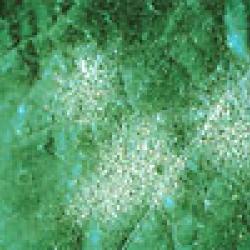Source Institutions
Source Institutions
Add to list Go to activity
Activity link broken? See if it's at the internet archive

In this laboratory exercise, learners will discover how many different plant hosts they can find that are infected by the same genus of a powdery mildew fungus, or how many different genera of powdery mildew fungi can be found on the same plant host. This exercise demonstrates the diversity that exists within a fungal order. With a good collection of leaves infected with different powdery mildew fungi (collected by learners or instructor), learners use a written key and/or an illustrated key (or could even make their own key) to identify the powdery mildew fungus to genus. Since powdery mildew fungi reproduce by means of two spore types, asexual spores (conidia) and sexual spores (ascospores), discussions of the types of reproduction in fungi can be facilitated. Note: This lab works best in regions that experience cold weather for part of the year, since this encourages production of cleistothecia (sexual stage). Please scroll down for activity component links.
- 10 to 30 minutes
- 45 to 60 minutes
- $1 - $5 per group of students
- Ages 11 - 18
- Activity, Experiment/Lab Activity, Lesson/Lesson Plan
- English
Quick Guide
Materials List (per group of students)
- Newspapers, old telephone books
- Plant press, heavy books, or large catalogues
- Manila envelopes
- Paper for collection labels
- Fresh or dried plant leaves with powdery mildew and mature (black to the naked eye) cleistothecia
- Water in dropper bottles
- Binocular dissecting microscopes
- Compound microscopes
- Dissecting needles or toothpicks
- Pencils with good erasers
- Micropipettes or Pasteur pipets and bulbs (optional)
- Microscope slides and cover slips
- Transparent tape
- Hot plate (optional but helpful)
- Large 800 ml beaker or coffee can (optional but helpful)
- Piece of screen to fit in the beaker (optional but helpful)
- Tong or forceps (optional but helpful)
- Envelopes (optional but helpful)
Subjects
-
Life Sciences
-
Diversity of Life
- Plants
- Protists and Fungi
- Classification
- Ecology
-
Evolution
- Evidence for Evolution
-
Diversity of Life
-
The Nature of Science
-
The Scientific Process
- Conducting Investigations
- Gathering Data
- Formulating Explanations
- Communicating Results
-
The Scientific Process
Informal Categories
- Gardening
- Nature and Environment
- Outdoor Activity
Audience
To use this activity, learners need to:
- see
- see color
- read
- touch
Learning styles supported:
- Involves hands-on or lab activities
Other
Components that are part of this resource:
This resource is part of:
Access Rights:
- Free access
By:
- Ruhl, Gail E. ; Jasalavich, Claudia A.
Rights:
- All rights reserved, The American Phytopathological Society, 2011
